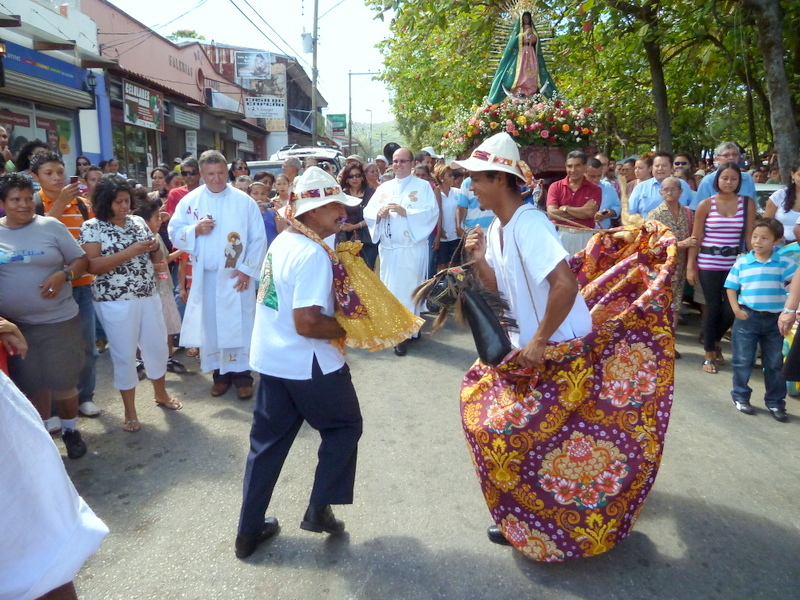Costa Rica Events – On December 12th of every year, a centuries-old folkloric celebration of the Virgin of Guadalupe and la Yegüita (the Little Mare) takes place in Nicoya, Guanacaste.
This festival marks the culmination of a long, complex, and highly structured community effort, supervised by a religious brotherhood, la Cofradía de Nuestra Señorita La Virgen de Guadalupe.
La Yegüita comes from a Chorotega Indian legend about twin brothers. On December 12th in 1653, the brothers were celebrating the Virgin of Guadalupe and had consumed an ample amount of chicha (corn beer). Both brothers were in love with the same woman, Nantiume. They began to fight over her with machetes. Terrified neighbors implored the Virgin to intervene and save them. Suddenly, a small black mare came out of nowhere. Kicking and biting, she got between the combatants and separated them. This was seen by the Chorotegas as divine intervention by the Virgin and has been celebrated ever since.
Today it is commemorated and celebrated with the Dance of the Little Mare. In the dance, the mare, la Yegüita (a carved wood and fabric costume with a braided tail) dances in quick swirling steps with la Muñeca (a small dressed doll on a stick), who represents a Chorotega woman calling to the Virgin with her movements. The dark color of the doll and the mare is seen as an indigenous attribute. The dance takes place in advance of the Virgin as she makes her way around town and, briefly, in church at the end of the Mass on December 12th.
 The Virgin of Guadalupe is the earliest and best known of the great Latin American virgins. She appeared in Mexico in 1531, just ten years after the conquest of the Aztec Empire by Hernán Cortés. She made herself known to Juan Diego, a recent convert to Catholicism, in Tepayac, near Mexico City.
The Virgin of Guadalupe is the earliest and best known of the great Latin American virgins. She appeared in Mexico in 1531, just ten years after the conquest of the Aztec Empire by Hernán Cortés. She made herself known to Juan Diego, a recent convert to Catholicism, in Tepayac, near Mexico City.
Her indigenous features and that she appeared to an Amerindian were very important to the relationship between the Spanish and native population. She became an early unifying cultural and racial force in the move toward a greater Mestizo culture. She is widely venerated today, both in Mexico and other countries, even in the US.
All aspects of the festival are organized and overseen by the Cofriadía. It is a community and religious organization dedicated to putting on the event in strict accordance with indigenous tradition and Nicoyan customs as handed down over generations. The organization of this brotherhood is very complex and involves many members.
All food prepared during the Fiesta is cooked with wood and there is a separate festival in November to cut the wood—La Pica de Leña, the cutting of firewood. The fuel is transported into town by a parade of beautiful Costa Rican oxcarts. The Pica has a considerable reputation for the consumption of alcohol. The local joke is that la Yegüita has worms and needs to be dosed with carbolina (a pesticide). In fact, carbolina is code for guaro (booze) which is consumed by the human participants. Locals will also tell you that carbolina sometimes causes la Yegüita to dance right off the street, but parasites are rarely a problem.
At 10 AM on December 12th there is a Mass, a two hour Mass. The Bishop of Tilarán officiates backed by at least a dozen priests. The church is packed. There is a brief appearance of la Yegüita and la Muñeca near the end of the ceremony after which the procession heads out of the church and down to the Cofradía. The Virgin is now ornately adorned and ready for her big day. She travels all around town during the day, but you don’t need an app to find her—just follow the explosions of the aerial bombs.
This fiesta, with its fusion, or syncretism, of Catholic and Chorotega beliefs, is a tradition that has been maintained for hundreds of years. It is very much a part of the cultural identity of Nicoya, Guanacaste. The residents are very proud of their Guanacastequidad, their Guanacasticity. The Nicoyanos and the Cofradía have every right to be proud of the roles they play in bringing this impressive religious and cultural event to life each year.
By Jack Donnelly, QCostaRica
No comments:
Post a Comment